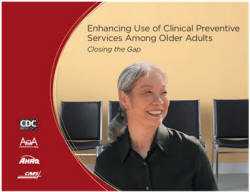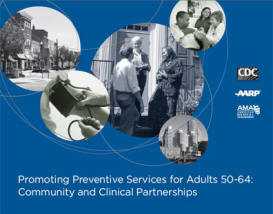Clinical Preventive Services
On This Page
- Increasing the Delivery of Preventive Services in Community Settings
- Healthy People 2020 Older Adult Topic Area
- Enhancing Use of Clinical Preventive Services for Adults aged 65 and Older
- Promoting Preventive Services for Adults aged 50-64
- CDC Focuses on Need for Older Adults To Receive Clinical Preventive Services

Given the rapid aging of the U.S. population, increasing the use of preventive services by adults aged 50 or older is a key public health strategy. Despite the effectiveness of these potentially life-saving preventive services:
- Only 25% of adults aged 50 to 64 years are up to date on services.
- Less than 50% of adults aged 65 years or older are up to date.
It is true that these services are covered, in part or completely, by most insurance plans, including Medicare and Medicaid.
Clinical preventive services – what are they?
Clinical preventive services can prevent disease or detect disease early, when treatment is more effective. These services include screenings for chronic conditions, immunizations for diseases such as influenza and pneumonia, and counseling about personal health behaviors. The U.S. Preventive Services Task Force (USPSTF) provides a complete list of all recommended services.
Increasing the Delivery of Preventive Services in Community Settings
Expanding sites for the delivery of preventive services beyond clinical settings is a promising public health strategy for increasing their use and closing the gap between current recommendations and what people are actually receiving.
Opportunities available through community settings to expand the use of potentially life-saving clinical services are described in a recently released “white paper”. This paper proposes a framework to integrate community and clinical care for a core set of services – services that produce the greatest health benefits for the dollars spent and are broadly applicable to the general population. Strategies identified in the paper are based on evidence-based models. Once developed, community-clinical integration could readily be extended to additional preventive services as well as to the care of chronic diseases and even acute conditions.
This paper, “A Framework for Integration of Community and Clinical Care to Improve the Delivery of Clinical Preventive Services Among Older Adults” [PDF–161KB] was prepared for the National Association of Chronic Disease Directors and the Michigan Public Health Institute with support from the Healthy Aging Program at the Centers for Disease Control and Prevention.
An article based on this paper titled “Clinical and Community Delivery Systems for Preventive Care: An Integration Framework” was published in the American Journal of Preventive Medicine in October 2013. This issue of the journal also includes a commentary related to the article, “Bridging the Why and the How of Clinical-Community Integration” .
Opportunity Knocks for Preventive Health
The series, Opportunity Knocks for Preventive Health, highlights the promise of collaboration between community-based sectors to improve the health of older Americans. This series of four briefs examines the roles that community organizations can play in increasing the use of potentially life-saving clinical preventive services (such as mammography, colorectal cancer screening, and influenza vaccinations) by adults aged 50 or older. Successful strategies and untapped opportunities are identified for
- Aging services providers.
- Public health departments.
- Community health centers.
- Other community organizations (such as YMCAs, workplaces, and pharmacies).
Each brief features real-world examples and links to resources that can help organizations initiate similar efforts in their own communities.
Healthy People 2020 Older Adult Topic Area
The Older Adult topic area in Healthy People 2020 includes an objective: Increasing the proportion of older adults who are up to date on the core set of clinical preventive services. The target of this objective is to increase by 10 percent the proportion of men (from 46.3% to 50.9%) and women (from 47.9% to 52.7%) who are up to date on the core set of clinical preventive services by the year 2020. This approach aims to provide a more meaningful measure of the delivery of clinical preventive services in the community.
Enhancing Use of Clinical Preventive Services Among Older Adults: Closing the Gap

In 2011, CDC, in partnership with HHS’ Administration on Aging, Agency for Healthcare Research and Quality, and Centers for Medicare and Medicaid Services released a report, “Enhancing Use of Clinical Preventive Services Among Older Adults: Closing the Gap.” The report underscores fundamental gaps by magnifying state and national self-reported data for adults aged 65 and older who are not receiving the recommended services, and highlights the need to link community and clinical strategies that focus on the underserved.
Promoting Preventive Services for Adults 50–64: Community and Clinical Partnerships

In 2009, CDC, AARP, and the American Medical Association released a report highlighting opportunities to broaden the use of potentially lifesaving preventive services. The report, “Promoting Preventive Services for Adults 50-54: Community and Clinical Partnerships,” identifies a set of recommended preventive services, delineates successful strategies to promote and facilitate their delivery in community settings, and provides national and state-level data to monitor progress in these services reach this key population.
Included in the report is a State-by-State Percentages for Key Indicators [PDF–1.2M] pull-out chart providing easily-referenced data for each state on key indicators for recommended preventive services.
CDC Focuses on Need for Older Adults To Receive Clinical Preventive Services
Each year, CDC releases critical issue briefs focusing on health issues for older adults. These briefs provide journalists, public health and aging services professionals, researchers, and others with current and easily accessible scientific and programmatic information on selected issues. In January 2012, CDC released a brief [PDF–99K] focusing on clinical preventive services for older adults.
- Page last reviewed: January 31, 2017
- Page last updated: January 31, 2017
- Content source:


 ShareCompartir
ShareCompartir